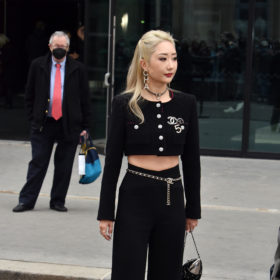
June 03, 2021 at 11:14PM
Ellie Kemper is known for the adorable girl-next-door she plays in basically all her roles — most notably as Kimmy in Unbreakable Kimmy Schmidt and Erin in The Office. When her name was recently trending on Twitter, some fans thought perhaps it meant they were getting a reboot or spinoff of their fave sitcom. But this is 2021, and nothing can be so simple. The actual reason Kemper was trending was because of an old, resurfaced photo of her as the “Queen of Love and Beauty” at St. Louis’s Veiled Prophet (VP) Ball, an organization known for its racist past and possible ties to the white supremacist Ku Klux Klan (KKK) group. *Sighs* Here’s what to know about this strange turn of events.
What exactly happened with Ellie Kemper?
It all started on May 31, when someone tweeted about the VP Ball in St. Louis, Missouri, calling it “a fancy event put on by our local KKK,” and adding that Kemper was once named queen of the ball. Following this, an old newspaper clipping from the St. Louis Post-Dispatch resurfaced on Twitter, featuring a photo of 19-year-old Kemper as the “1999 Veiled Prophet Queen of Love and Beauty.” Kemper is shown wearing a white debutant gown with long white gloves, and the tweet dubbed her the “KKK queen.” Yikes.
So was no one gonna tell me Ellie kemper aka kimmy Schmidt was crowned KKK queen in 1999 pic.twitter.com/QdHJ6wGZGv
— charlie (@dianahungerr) May 31, 2021
“Ellie Kemper” began trending on Twitter, with speculations circulating about the organization’s ties to the KKK, and memes poking fun at how ridiculously terrifying this is. To no one’s surprise, it turns out the Veiled Prophet Organization indeed has a dark and disturbing past, so buckle up.
ironically the best gif reaction to the ellie kemper news comes right from kimmy schmidt pic.twitter.com/Fcaow7ZwVI
— shauna (@goldengateblond) June 1, 2021
ADVERTISEMENT
ADVERTISEMENTKate Spade Autumn/Winter Sale |
What is the Veiled Prophet Organization?
Back in 2014, Scott Beauchamp did a deep dive into the history and practices of the organization for The Atlantic , and there’s a lot to unpack. The group was founded in 1878, when a confederate soldier brought together the local white “elites” to create a secret society: the Veiled Prophet Organization. Every year, a secret board would name someone the Veiled Prophet. The chosen VP (whose identity would remain anonymous) would then select a Queen of Love and Beauty at the organization’s debutante ball. The ball’s guest list was confidential, but only the town’s wealthiest and most powerful could attend, and the event was accompanied by a parade and fair.
The VP Organization was founded in response to the growing civil unrest of the working class. A year prior to its formation, railroad workers started the national Great Railroad Strike, where they halted train cars to draw attention to the unethical working conditions and unfair pay they endured. When the strike reached St. Louis, the town’s workers protested in solidarity with the strikers, calling out the disparity between the predominantly white wealthy elites and the working class. The strike ended when 5,000 “special police” joined forces with federal troops to disperse the crowd, killing eighteen strikers. The following year, the Veiled Prophet Organization was founded to assert the power and wealth of St. Louis’s white elite.
Organizations like the Veiled Prophet were very common in late 19th century America, says Andrew Johnston, a history professor at Carleton University. Organizations that were filled with white, Protestant, upper-class members were commonly established after periods of labour unrest. The “American governing class” felt threatened by the working class, immigrants and racialized people, he said, and used these organizations to exert dominance over them. “There was growing consciousness of racial competition, and it was just getting worse,” says Johnston, adding that St. Louis has historically been a hotbed of racial violence.
So, is the Veiled Prophet Organization tied to the KKK?
There is no public evidence directly tying the two organizations to one another, but the VP organization’s history is undeniably racist. In the earlier years of the VP’s parade, there were racial stereotypes depicted on the floats. Black and Jewish people weren’t allowed to be part of the organization for many years, and were only given admittance in recent decades. Perhaps the most jarring is the image of the first Veiled Prophet, who is dressed in a white cloak and is armed with a shotgun and pistol, seemingly modelled after a Klansman.
Mathew Czipf, a masters student at Carleton University studying the connections between the KKK and other white supremacist groups, says members of the VP Organization were likely to run in the same social circles as those in the KKK. Secrecy was a pillar of these organizations, allowing members to maintain political power and influence without the stigma of being in a white supremacist group.
“The people who wanted to join the Klan or get involved in white supremacy explicitly would find the Klan first, realize that they can’t advance their ideas or agendas through the Klan anymore because of how heavily policed it is, and then move out into smaller organizations, organizations by different names,” said Czipf.
By 1992, the name of the Veiled Prophet Fair was changed to Fair St. Louis, in an effort to rebrand and remove the connection to its past. But the organization still exists, representing longstanding inequities in St. Louis. The annual debutante ball exists too, in which young women from wealthy St. Louis families are presented to a “Veiled Prophet.”
What’s our takeaway?
To put it plainly: this whole thing is messed up. But sadly, it’s not that surprising. Kemper comes from old money and a privileged background; her family founded Commerce Bancshares, and she attended Princeton. Membership from the country’s wealthiest white families to groups like the Veiled Profit Organization does not come as a shock. While this is certainly not a good look for Kemper, it’s indicative of a larger issue within American history and culture: that organizations with such disturbing pasts continue to live on through traditions like the Veiled Prophet Ball.
I mean it is fucked up that white supremacy is that ubiquitous and overlaps this hard with seemingly normal liberal types but the takeway from this should be an indictment of all of that instead of just conveniently compartmentalizing it off into the one person that got busted
— please stop yelling at me i am a comedian (@feraljokes) June 1, 2021
Kemper has not yet responded to the situation, and whether she knew the extent of the organization’s history or not, it comes down to the importance of being socially aware. Johnston said claiming not to know about the history of a social issue such as this “means you either didn’t know because you weren’t listening, you chose not to know, or you lived in a circle of life that was completely cut off from those things.” Whatever the reason may be, it’s never too late to start learning, unlearning and taking accountability.
The post What’s the Deal With Ellie Kemper and a Racist Debutante Ball? appeared first on FASHION Magazine.
Read More Fashion News
Author Natalie Michie | Fashion Magazine
Selected by CWC
ADVERTISEMENT
ADVERTISEMENTUp to 30% off Gift Sets |






